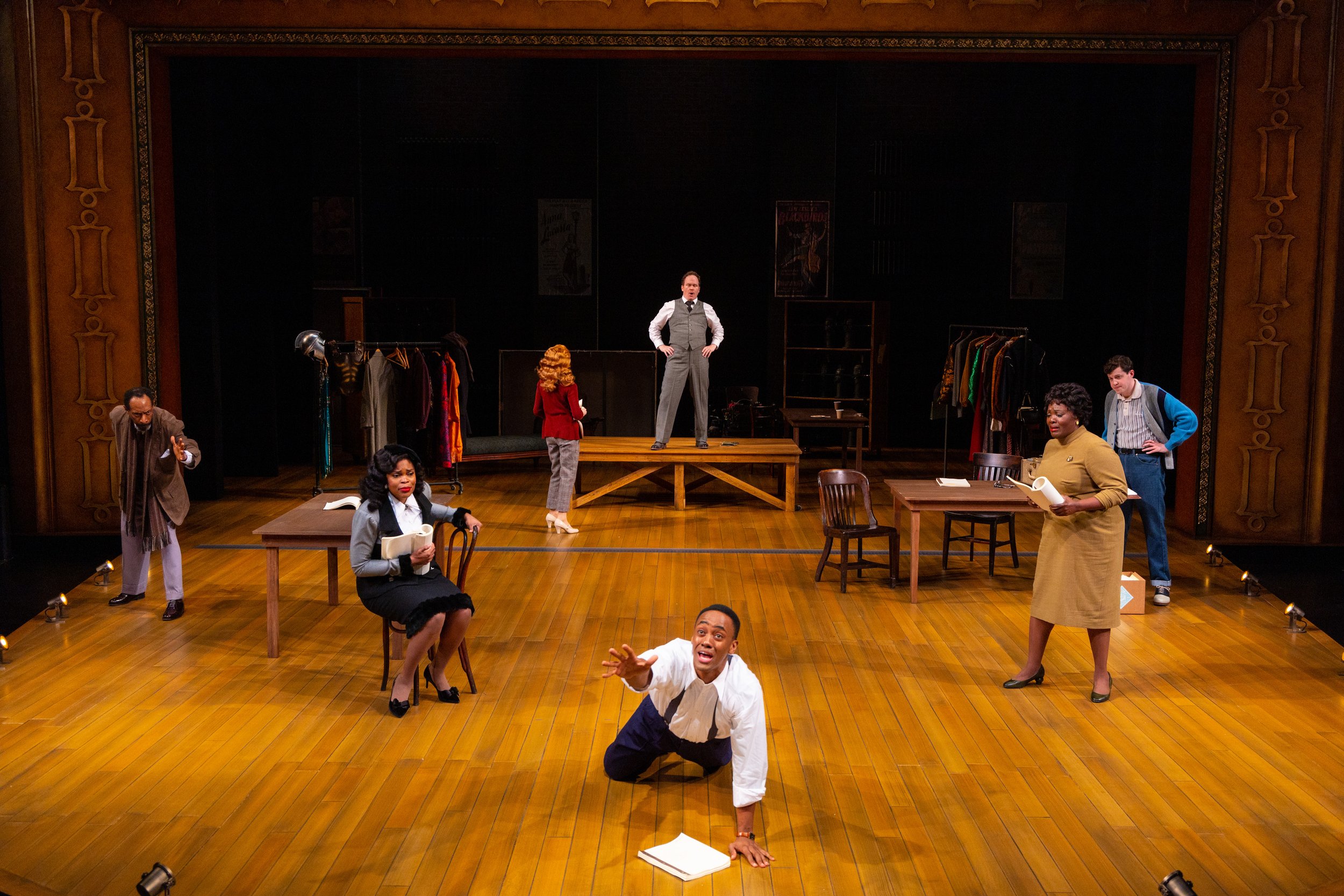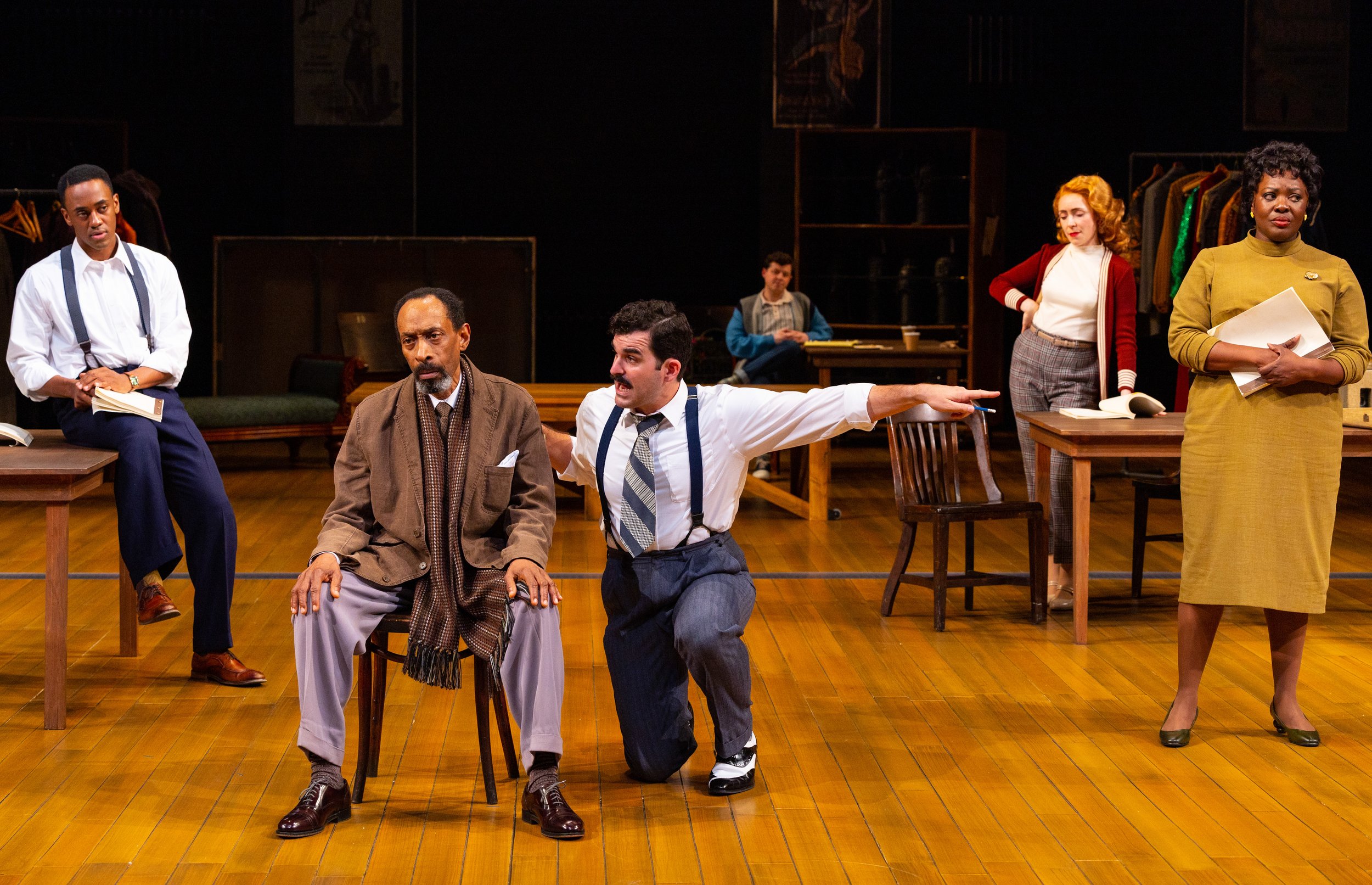Review of Trouble in Mind, Hartford Stage
The purpose of theater in both addressing a public and creating a viable theatrical space in which talent is showcased and convincing dramatic or comic roles are enacted is under scrutiny in Alice Childress’ complex, satiric, and politically motivated play from 1957, Trouble in Mind. Within this exploration of the rigors of a professional production—we’re supposedly watching the rehearsals for an upcoming Broadway show, Chaos in Belleville—there is plenty of room for Childress to examine the plight of theater in her day, which turns out to be not very different from the concerns of our day. The plight of trying to do truth while at the same time shackling a play’s messages and meanings to holdover clichés, stereotypes, or to whatever new theatrical mannerisms (in this case Method Acting) have arisen to christen a new era looms large. In our day, the question of diversity on all fronts has all but ended any notion of theatrical unity; in Childress’ time, the process of chipping away at the Great White Edifice on the Great White Way was just getting underway.
The cast of Trouble in Mind at Hartford Stage, directed by Christopher D. Betts (photo by T. Charles Erickson)
Childress, who spent a long time as an actress herself, knew the lingo, knew the backstage chat and sparring, and had observed and experienced the little indignities and the overweening egoism of actors’ lives. What helps sustain our interest in this collection of actors--Wiletta Mayer (Heather Alicia Simms), Sheldon Forrester (Michael Rodgers), Bill O’Wray (James Joseph O’Neil), Judy Sears (Sarah Lyddan), Millie Davis (Chelsea Lee Williams), and John Nevins (Sideeq Heard)—is the way they play with the parts in the Belleville play and play their own roles in the process of creating theater. So, while Judy might seem at first a perky airhead, that’s partly because her ingenue role expects it of her; meanwhile, a practiced dissembler like Sheldon Forrester—the elder in the company—knows how to act “the darkie” in a way that puts white egos at ease, while also asserting himself—via voice and histrionic presence—as an actor in the grand manner. Bill O’Wray, a soap opera star, treats every role as a job he pretty much plays the same way, not interested in interacting with the cast or exploring method; Millie Davis shows off gaudy jewelry to convince her colleagues she doesn’t really need to act, so well-off is her husband, and so maintains a certain aloofness; John Nevins is the newbie, earnest and ingratiating but his ambition—to use the play as a vehicle to launch his career—is as real as anything. Then there’s Wiletta Mayer, who reluctantly emerges as the conscience of the cast, a role for which she hasn’t fully explored all the implications.
We first meet Wiletta as she arrives earliest to rehearsal. This gives her the opportunity to interact with Henry, an aging theater-hand who remembers a grand theatrical moment in her past career—for which he designed the lighting. With that exchange, Childress stresses her sense of theater: it’s ephemeral even at its best, and yet—as an experience—it can create a longstanding awareness shared by these two who achieved something together even if only meeting for the first time. The tension between who they are at their best—in the theater—and who they are otherwise (just folks) is clear from the start. That contrast inspires mostly comic deliveries, but Betts downplays Childress’ satire as though the target of playing at playing is too easy and too readily assessed. What does emerge is that “Tomming”—assuaging white egos by playing up to them, like an “Uncle Tom”—is key to success for black actors but that some version of such dissembling (kissing-ass) is an element generally present wherever hierarchies preside. So that Eddie (Adam Langdon), the white put-upon assistant to the white director Al Manners (John Bambery) is pretty much always “Tomming,” as is Henry.
In my view, the biggest problem with the Hartford Stage production of this intriguing play is John Bambery’s Al Manners. Having seen a very nuanced rendering of this character in another production, I have a hard time getting a read on why Manners is so incessantly tiresome. Bambery approaches his lines as if hacking away at blocks of ice, whereas the character—as a director who feels he’s actually progressive while having to deal with indignities on all sides (from an ex-wife, from his producers, from his cast, and his underlings)—has a trajectory to run: from seeming to know how this works to not having a definite conviction any longer. It’s worth mentioning the weak point of the production because it seems to me that the strength of the real director’s approach is Christopher Betts’ willingness to push this play until “not having a definite conviction” is a state of affairs that can’t really be improved and can only be endured.
Early on, Manners tries to lord it over Wiletta, after she sings a song in the play with the kind of subdued, spiritualist fervor she knows he wants. Not content, he eggs her on with “word association” and other Method techniques to make her question and “justify” her choices. The next rendition has a different register, much closer to “we shall overcome,” a rallying cry. Manners rejects the innovation at once and so the cast (and us) see that he’s all bluster, not really wanting to find new possibilities in trite material. It’s a fully present moment, convincingly played.
John Nevins (Sideeq Heard), Sheldon Forrester (Michael Rodgers), Al Manners (John Bambery), Eddie (Adam Langdon), Judy (Sarah Lyddan), Wiletta (Heather Alicia Simms) in the Hartford Stage production of Trouble in Mind (photo by T. Charles Erickson)
More questionable is a key moment in Act Two: the play—Chaos in Belleville—is an “anti-lynching” play in which a young black man gets lynched (though other outcomes might be possible). Someone says that none present have ever seen a lynching and that’s when Sheldon Forrester speaks up. He has, and proceeds to describe what he saw. In Rodgers’ delivery as Forrester, the tale takes on a rhapsodic feel, working against the excruciating detail of what he tells. It’s as if Betts has chosen to let Forrester—a thoroughly theatrical presence—turn actual oppression into aria (as theater will do again and again). The point is that Childress’s play, in openly questioning, through Wiletta Mayer, all the givens of a play like Chaos in Belleville, with its crowd-pleasing and guilt-assuaging BS, also questions how to render the theatrical reality of her own play, a question that Betts’ production worries to the end.
According to Arminda Thomas’ account in the show’s playbill, the play’s ending continued to be an issue. When the play was bound for Broadway, Childress baulked at the suggested ending (the actors all agree with Wiletta against Manners) and the play was not produced; as late as 1992, for a London production, Childress reworked the ending. The problem of the ending, we could say, is that the play can’t solve it. No actor, no director hired to put on a particular play can really change it to make it their own play. What is needed is a black female playwright able to write a better play than Chaos in Belleville, and—while she knows she is that playwright—Childress chooses to write a play that dramatizes that need rather than resolving it. At play’s end, it’s not Wiletta we have to believe in but in Childress, in Lorraine Hansberry, in Adrienne Kennedy, in Suzan-Lori Parks. We know they are coming, but they’re not there yet (in the play).
By restaging this early confrontational play, Betts lets us work through the problems that won’t go away: How to authentically enact what you never experienced when so many want to own a particular history? The cast becomes more and more convinced that they don’t know how the play should be rendered, as if in a proto “We Are Proud to Present a Presentation…” (which Betts directed while a graduate student), and Childress knows there is real drama in that realization. Or: How to put audiences on the hook and then let them off the hook so that they go away feeling vindicated for their sensitivity? That element—which we can say is still the earmark of the successful play able to enact uplift from suffering—is already questioned by Wiletta’s different renderings of a song, or by her choice at the end of making a speech where the principal of radical theater requires her not to do it “in character,” but however she happens to feel right now, as we conclude. And how we feel about that is all about whether or not we are with her as she grapples with the constraints and the freedoms her playwright and her director (Childress and Betts) put upon her.
The “trouble” of Trouble in Mind is that it’s purpose is to trouble the waters, not resolve the issues. Our task is to watch the agitation and think through its implications. To keep all that trouble in mind, until it does someone some good.
Trouble in Mind
By Alice Childress
Directed by Christopher D. Betts
Scenic Design: Baron E. Pugh; Costume Design: Jahise LeBouef; Lighting Design: Emma Deane; Sound Design: Kathy Ruvuna; Wig Design: Carissa Thorlakson; Dramaturg: Arminda Thomas; Casting Alaine Alldaffer; Production Stage Manager: Avery James Evans; Assistant Stage Manager: Anaïs Bustos
Cast: John Bambery, Sideeq Heard, Richmond Hoxie, Adam Langdon, Sarah Lyddan, James Joseph O’Neil, Michael Rodgers, Heather Alicia Simms, Chelsea Lee Williams
Hartford Stage
May 25-June 18, 2023

